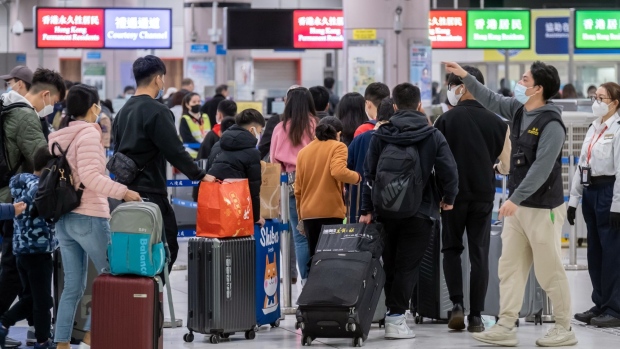Feb 19, 2023
Hong Kong Airport’s Passenger Volume Surges as China Reopens
, Bloomberg News

(Bloomberg) -- The number of people passing through Hong Kong’s airport jumped last month as travel restrictions eased and China reopened borders for the first time since the pandemic began.
Hong Kong International Airport reported 2.1 million passengers in January, about 2,800% higher than the same period last year. Traffic to and from Southeast Asia and Japan recorded the most significant increases, according to a press release from airport authorities.
China’s move to reopen borders with Hong Kong, coupled with pent-up demand to travel for the Lunar New Year break, helped fuel the surge. The city is eager to restore its status as a global financial hub and gateway to China — its largest source of tourism and biggest trading partner — since its economy took a sharp blow amid the prolonged closure.
Hong Kong has been removing pandemic restrictions since China ended its Covid Zero policy, and has effectively returned to normal with the exception of a mask mandate. Earlier this month, daily quotas and testing requirements were dropped and all boundary checkpoints opened.
In a bid to attract tourists, officials this month launched a tourism campaign that includes distributing more than 500,000 free air tickets this year. The Airport Authority purchased the tickets in 2020 as part of a HK$2 billion ($255 million) rescue package for the airline industry.
Mainland visitors to Hong Kong could rebound this year to 78% of 2019 levels with the removal of restrictions including the daily traveler quota and mandatory Covid tests, according to Bloomberg Intelligence.
The number of such visitors this month and in March could rise above the monthly average of 2.4 million in the second half of 2019 when demonstrations were going on, analysts including Catherine Lim wrote.
Hong Kong was Asia’s busiest international airport before Covid. January’s data represent only a third of the traffic the airport experienced in the same period four years ago. The government wants to revive the city’s global brand after three years of self-imposed isolation during the pandemic, protests and the imposition of tough security laws. Gross domestic product shrank 3.5% last year, the third contraction in four years.
(Updates to add more details of BI forecasts. Earlier versions of this story corrected the percentage growth figure in second paragraph and to say daily visitor quotas were dropped earlier.)
©2023 Bloomberg L.P.


